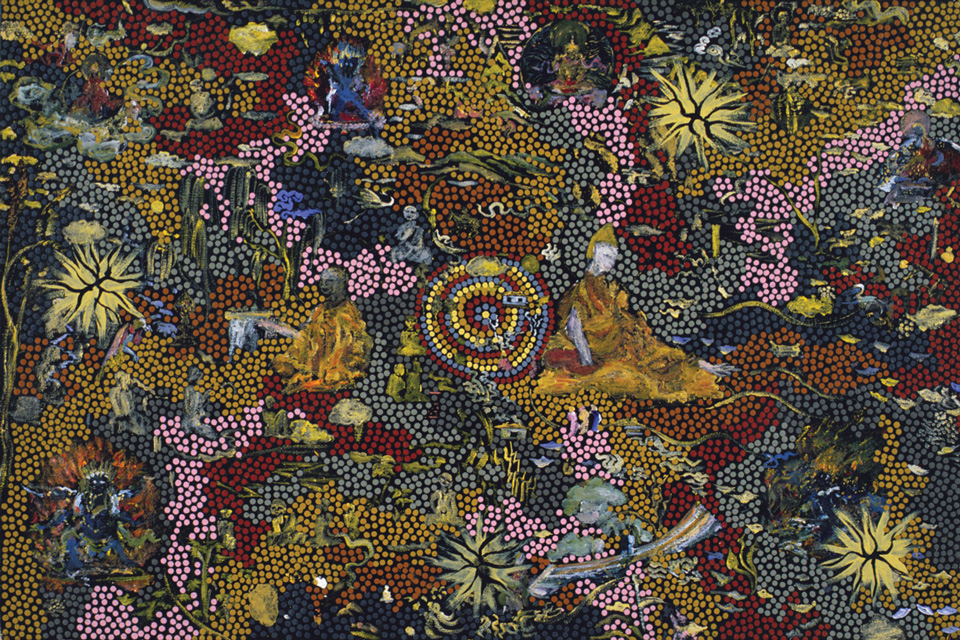


Tim Johnson has been at the forefront of experiment in more than one phase of contemporary Australian art. Around 1970, the former architecture student from the University of Sydney was one of several practitioners of a new 'post-object' conceptual art, performance art and musical performance. By the late 1970s, Johnson had re-emerged in a new guise, making photographs and small acrylic paintings that documented his experiences and friendships; after 1980, these figured Aboriginal painters at Papunya, the Central Australian government settlement that since 1971 had been the home of the vital new dot painting movement.
For the next decade Tim Johnson was the most notable white Australian artist whose work engaged with Aboriginal art. This took place on several levels: he used dotting techniques and perspectival schemes inspired by Papunya art; he formed (with his then wife, the critic and historian of Western Desert art, Vivien Johnson) one of the finest private collections of Papunya painting; and he befriended the prominent artists Turkey Tolson Tjupurrula, Michael Nelson Jagamara and Clifford Possum Tjapaltjarri, making collaborative works with all three. Johnson's apparent appropriation of their art caused controversy in the later 1980s, before the cultural basis of his interventions with Indigenous artists was properly understood, when he was parcelled together with the Sydney post-modernist, Imants Tillers (whose practice has a very different philosophical basis).1
Johnson's status today is that of the most consistent, culturally sensitive and aesthetically successful exponent of the cross-cultural gesture that typifies postcolonial art in this country.2 The three small works in the Vizard Foundation Collection exemplify the breadth of his recent activity, with the focus on collaboration. This term needs some explaining: although anonymity and collaboration was the hallmark of art workshops of the early Renaissance, in nineteenth-century and twentieth-century western art the individual artist was exalted as a way of guaranteeing value. With the arrival of post-modern theories of the 'death of the author', the named artist was no longer the unique source of images, which could be borrowed from others and recombined in ways that disguised the individual will.
Johnson relies less on such appropriations and recombinations than on a more 'organic' painterly exchange. Willing to submerge his personality as one voice among others, Johnson has acted as a kind of orchestrator of pictures; he then uses his status as a professional artist to exhibit and sell them, distributing the proceeds to his colleagues. For him, collaboration has been an activity of exchange with artists he admires. As he writes:
In a sense the paintings are theoretical landscapes. The collaborative aspect of the work, besides being just two people sharing an activity, is a way of crossing the cultural barrier. Karma Phuntsok, My Le Thi, Edward Johnson ... have all added to the paintings with ideas and imagery from their own cultural backgrounds’.3
The earliest of the three works, Reincarnation (1993), is a collaboration with Clifford Possum Tjapaltjarri (d. 2002), the celebrated Papunya painter. In several earlier collaborations the Indigenous artist painted the leitmotif of Dreaming-tracks or tjukurrpa, while Johnson did the dots or other infill. In Reincarnation, Johnson prepared the canvas and painted the motifs of Tibetan deities, gold-robed monks, willow-trees and clouds that float in an uncertain atmosphere. He then sent the canvas to Tjapaltjarri for completion with areas of crisp dots and the yellow sunburst motifs that symbolise the sacred desert yam. The result has a strange beauty, and forms the visual proposition of a link between Tibetan and Aboriginal religiosity: a proposition compounded by the title, reincarnation being a concept important to both cultures.
Snow lion (1998) records Johnson's increasing engagement with the world of Tibetan art and belief in the 1990s. Since the early 1980s, the artist had occasionally made paintings inspired by Buddhist iconography, and in stages had become a practising Buddhist himself. He made multi-media installations including genuine Tibetan mandala paintings (or thankas), and began working collaboratively with a Tibetan émigré to Sydney, Karma Phuntsok. In such works, the crisp detail of Phuntsok's traditional technique contrasts with Johnson's ethereal weavings of paint. Here, a two-wheeled celestial vehicle, with the lotus-flower taking the place of the divine, is drawn through Johnson's cloudscape by a green-tasselled, snow-white lion: the snow lion, an auspicious and protective beast.
The surprising advent of a fleet of blue–white flying saucers in Western desert UFOs (1997) is driven by the artist's own conviction that extra-terrestrials exist, and have visited earth. Johnson has them appear in the skies over the golden lands of Central Australia (there have been repeated sightings at Wyecliffe Well). He interprets that country by reverting to the dotted facture he first learned at Papunya. The opposite of a rationalistic Anglo-Australian in his syncretistic spirituality, Tim Johnson's world of belief has fuelled a body of work that consistently takes a turn to the unexpected.
- Roger Benjamin
Tim Johnson is represented in Australia by Tolarno Galleries, Melbourne.